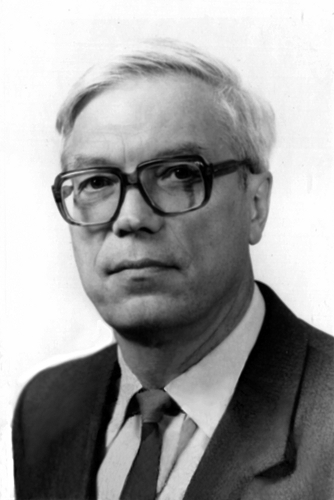 V. I. Slysh, mid-1990s. (Slysh family photograph)
V. I. Slysh, mid-1990s. (Slysh family photograph)
Vyacheslav Ivanovich Slysh
Contributed by Leonid Gurvits
Vyacheslav Ivanovich Slysh ("Slava" as known to many his friends and colleagues) was born on 19 November 1935 in Kharkov, Ukraine. He graduated from the Moscow Power Engineering Institute in 1959, postgraduated from the Institute of the Terrestrial Magnetism, Ionosphere and Radio Wave Propagation in 1962 and Moscow State University in 1964. His tutor in astrophysics at the MSU was Joseph Shklovsky. In 1977, V. Slysh obtained the degree of Doctor of Sciences. In 1997, he was elected as a Corresponding Member of the Russian Academy of Sciences.
Vycheslav Slysh began his career as an engineer at the P.N. Lebedev Physical Institute of the USSR Academy of Sciences in 1959, and continued as a junior researcher at the Sternberg Astronomical Institute of the Moscow State University in 1962-1968. Since 1968 he worked as a Head of the Radio Spectroscopy Laboratory and Head of the Department of Astrophysics at the Space Research Institute of the USSR Academy of Sciences. In 1990, together with the Department, V. Slysh moved to the Astro Space Centre of the P.N. Lebedev Physical Institute where he became a Deputy Director (1990-2005) and Head of Department (1990-2008).
In 1963, V. Slysh proposed a method of determination of sizes of celestial sources of synchrotron emission (known as the "Slysh formula" in the literature) and predicted the existence of radio sources associated with quasars and active galactic nuclei. He demonstrated that non-stationary sources can contain ultra compact nuclei with brightness temperature exceeding the synchrotron limit. He conducted first investigations of low frequency radio emission of the Sun and the Galaxy using the spacecraft 'Venera', 'Mars', 'Luna-11,12'. As a result of these investigations, the role of the galactic ionized gas in the formation of the synchrotron spectrum of the Galaxy has been exposed. In these experiments, low frequency flashes of solar radio emission have been discovered. These flashes have been shown to be related to the transfer of flows of energetic particles and shocks from the solar corona to the interplanetary medium. Later, he studied interstellar molecules of hydroxyl, water, formaldehyde and methanol, and discovered a large number of sources of maser emission in the Galaxy associated with star formation regions. V. Slysh proved that masers related to the star formation regions, in particular the masers in lines of interstellar hydroxyl, were situated deep within molecular clouds. He conducted large surveys of the Galaxy searching for new methanol masers and discovered about 100 new sources. He was one of the initiators the new 70 meter radio telescope on the plateau Suffa in Uzbekistan, the space radio interferometer RadioAstron.
V. Slysh was a member of Scientific Council on Astronomy of the Russian Academy of Sciences, a member of the International and European Astronomical Unions. He was awarded the Bredikhin Medal of the Russian Academy of Sciences for outstanding work in astronomy. He published more than 200 scientific papers.
Vyacheslav Ivanovich Slysh passed away in Moscow on 22 September 2008.
Modified on Tuesday, 17-Dec-2019 10:50:32 EST by Ellen Bouton, Archivist (Questions or feedback)
|
![[IAU logo]](iau_wb_thumb.jpg)
![[URSI logo]](URSI-logo-thumb.jpg)
![[Karl Jansky at his antenna]](jansky_photo_02_thumb.jpg)
![[Reber's Wheaton antenna]](Reber_Telescope_Wheaton_thumb.jpg)
![[Dover Heights]](Dover_Heights_02_thumb.jpg)
![[4C telescope]](GB61-195_4C_telescope_thumb.jpg)
![[Ewen and horn antenna]](ewen_horn1s.jpg)
![[Dwingeloo, 1956]](Dwingeloo-1956-thumb.jpg)
![[Jocelyn Bell Burnell and Cambridge antenna used in pulsar discovery]](burnell2_thumb.jpg)
![[Lovell Telescope at Jodrell Bank]](site_1594_0001-500-334-20180316163019-thumb150.jpg)
![[Wilson, Penzias, and Bell Labs horn antenna]](wilson-penzias-horn_thumb.jpg)
![[6-m Millimeter Radio Telescope in Mitaka, Japan]](6m-thumb.jpg)

